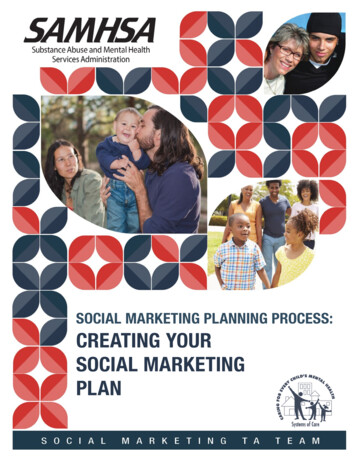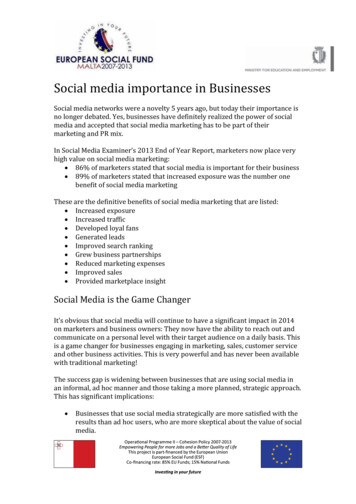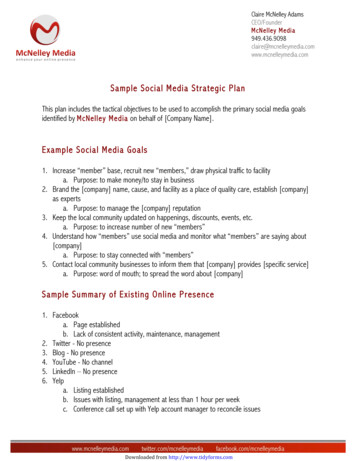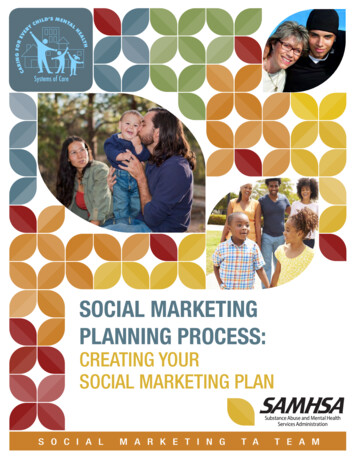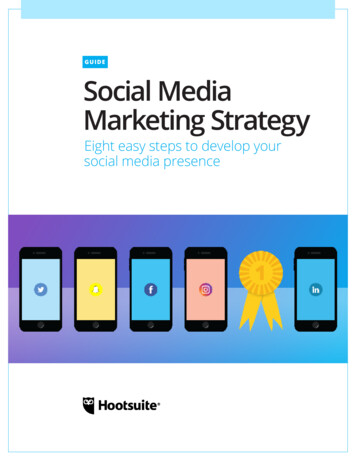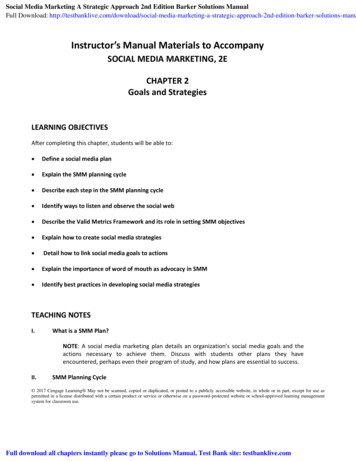
Transcription
Social Media Marketing A Strategic Approach 2nd Edition Barker Solutions ManualFull Download: tions-manuInstructor’s Manual Materials to AccompanySOCIAL MEDIA MARKETING, 2ECHAPTER 2Goals and StrategiesLEARNING OBJECTIVESAfter completing this chapter, students will be able to: Define a social media plan Explain the SMM planning cycle Describe each step in the SMM planning cycle Identify ways to listen and observe the social web Describe the Valid Metrics Framework and its role in setting SMM objectives Explain how to create social media strategies Detail how to link social media goals to actions Explain the importance of word of mouth as advocacy in SMM Identify best practices in developing social media strategiesTEACHING NOTESI.What is a SMM Plan?NOTE: A social media marketing plan details an organization’s social media goals and theactions necessary to achieve them. Discuss with students other plans they haveencountered, perhaps even their program of study, and how plans are essential to success.II.SMM Planning Cycle 2017 Cengage Learning May not be scanned, copied or duplicated, or posted to a publicly accessible website, in whole or in part, except for use aspermitted in a license distributed with a certain product or service or otherwise on a password-protected website or school-approved learning managementsystem for classroom use.Full download all chapters instantly please go to Solutions Manual, Test Bank site: testbanklive.com
NOTE: The Social Media Marketing Planning Cycle is an nine-step model for developing asocial media marketing plan through a continuous process of listening, setting goals,defining strategies, identifying the target audience (market), selecting tools, selectingplatforms and channels, implementing, monitoring, and tuning. Discuss each step in theprocess with students and how tuning leads back to a new cycle beginning with morelistening.NOTE: Listening to what people are saying about a company enables the organization todetermine its current social media presence, which in turn guides the setting of social mediagoals and strategies to achieve them.NOTE: Setting goals is done by pinpointing the location, behavior, tastes, and needs of thetarget audience and conducting a competitive analysis to determine an organization’sstrengths and weaknesses and the opportunities and threats in the environment.NOTE: Defining strategies must be done on a case-by-case basis, using all availablepertinent information.NOTE: Identifying the target audience (market) enables a company to organize itsmarketing strategies to efficiently reach those most receptive and likely to becomecustomers and even brand advocates.NOTE: Selecting tools is accomplished by finding the social media sites where the targetaudience resides and then focusing the company’s social media efforts on those platforms.NOTE: Selecting platforms and channels identifies the paths by which content will betransmitted to the target audience. Social media platforms are the websites on which socialmedia communications take place (i.e., Facebook, Twitter, others). Channels are broaderentities composed of multiple platforms and other technologies (i.e., mobile).)NOTE: Implementing is the process whereby the goals, strategies, target market, and toolsare taken into consideration in creating actionable social media platform-specific marketingtactics.NOTE: Monitoring is the process of tracking, measuring, and evaluating an organization’ssocial media marketing initiatives.NOTE: Tuning is the constant and continuous process of adjusting and improving theelements of the plan to maximize the chances of success.III.Listen and Observe: Five StagesNOTE: During the listening and observing stage, marketers should follow conversationsabout a particular brand and company, its competitors, and the relevant industry on as 2017 Cengage Learning May not be scanned, copied or duplicated, or posted to a publicly accessible website, in whole or in part, except for use aspermitted in a license distributed with a certain product or service or otherwise on a password-protected website or school-approved learning managementsystem for classroom use.
many social media platforms as possible. Discuss with students the process for establishingaccounts on various social media platforms and strategic selection of platforms for listening.NOTE: It may also be useful to discuss tools within platforms such as search features andgroups that make listening to conversations more targeted to the specific business.NOTE: Stage #1: The first stage is listening to and observing conversations about aparticular company. Listen to the conversations taking place on blogs, Twitter, discussionforums, websites, LinkedIn, Facebook, etc., to understand how the company is perceived.Both positive and negative remarks can show where opportunities may lie. Discuss withstudents how negative remarks can be useful to a business.NOTE: Stage #2: Next, listen to what people say about a company’s competitors, and whatthose competitors are saying about themselves. Assessing the competitive landscape onsocial media sites will show how buyers are meeting sellers on social media and may provideinsights that can be leveraged when later building a strategy. Discuss with students ways toidentify competitors.NOTE: Stage #3: After observing the competition, begin listening on a broader scale: theoverall industry. Listening at the category or industry level will help one understand whatthe consumers in that industry are really interested in talking about. Discuss with studentshow this information can be useful in other business decisions or identifying industry trendsrelated to products and services.NOTE: Stage #4: The next stage is to listen for the Tone of the Community, or how yourconsumers naturally interact with each other on social sites. This knowledge will facilitateintegration and participation in the community. Discuss potential impacts of participatingwithout understanding the Tone of the Community.NOTE: Stage #5: Finally, when listening to social media, be sure to access multiple socialmedia channels to identify where target audiences hang out and what they do there. Sincethe users on each site and the social networking structure are different, it is important tolisten to conversations across a variety of social media channels. Discuss the common socialmedia channels, such as Facebook, Twitter, and LinkedIn, and the various target audiencesthat might exist on those channels.Listening as Part of Personal Branding StrategyNote: Listening is also the first step in developing a personal brand.IV.Listen and Observe: Listening CentersNOTE: The National Football League listens to Super Bowl Conversations. In 2012, the NFLestablished an early social media listening center for Super Bowl XLVI. A team of over 20“strategists, analysts and techies” monitored fan conversations on the Monday before the 2017 Cengage Learning May not be scanned, copied or duplicated, or posted to a publicly accessible website, in whole or in part, except for use aspermitted in a license distributed with a certain product or service or otherwise on a password-protected website or school-approved learning managementsystem for classroom use.
game and during the game, tweeted everything from parking directions to informationabout Indianapolis’ attractions. The command center delivered some 1.8 million onlineimpressions each day. For the 2015 Super Bowl, statistics are reported in Figure 2.2. Askstudents whether they participated in these communications.NOTE: Cisco demonstrates the importance of social media listening in B2B Marketing. Discois listening to:Social Media Customer Engagement (highlighting CiscoLive conversations)Twitter-based global heat map (Where?)Social Media influencers (Who?)Product Family Landscape (What conversations)Social Media Word Cloud Highlighting (current trending topics)V.Setting Goals and ObjectivesNOTE: Listening to a wide range of social media sites and observing the location, behavior,tastes and needs of the target audience is key to successful SMM. Social media marketinggoals include brand building, increasing customer satisfaction, driving word-of-mouthrecommendations, producing new product ideas, generating leads, handling crisisreputation management, as well as integrating social media marketing with public relationsand advertising.NOTE: It is important to keep in mind that goals must be flexible in the light of newdevelopments while engaging in social media. Discuss how goals might change based oninformation from social media engagement. Sometimes, unexpected benefits from socialengagement are discovered.NOTE: The Vistaprint example shows that people often seek customer support throughTwitter. Vistaprint engaged its customer service department to respond directly to thetweets. Discuss with students what examples they have seen of such programs.NOTE: Brand building goals include: increasing brand awareness, improving brandperception, positioning a brand, and expanding brand loyalty.NOTE: Firms received increased market insight, improving business partnerships, and lowermarketing costs as a result of SMM. Figure 2.4 shows other potential benefits.NOTE: Social media has caused significant changes in search ranking. Search engines tend tofavor the sites with the greatest number of inbound links from well-respected sites by 2017 Cengage Learning May not be scanned, copied or duplicated, or posted to a publicly accessible website, in whole or in part, except for use aspermitted in a license distributed with a certain product or service or otherwise on a password-protected website or school-approved learning managementsystem for classroom use.
ranking them higher in search results. Building a strong social media presence increased thenumber of links to your website content resulting in potential higher ranking on searchengines. Of the ten most important ranking factors seven were social signals.NOTE: Other objectives of SMM include achieving a desired brad positioning, producing newproduct ideas, being prepared to handle reputation management in a crisis, and supportingpublic relations and advertising campaigns.NOTE: There is beginning to be some agreement about the types of objectives that arteappropriate for SMM, although many marketers still have their own favorite variant of theones shown in Figure 2.5. Ask students whether they agree or disagree with theseobjectives.NOTE: It helps to understand objectives as a cascade. See Figure 2.6. Some generic conceptsused in SMM include: exposure, engagement, influence, impact and advocacy. This is aprogression that may parallel the purchase journey itself.NOTE: There is a standard for judging the quality of goals and objectives at any level. It is theSMART acronym:S pecificM easurableA chievableR ealisticT ime delimitedNOTE: Because SMM campaigns vary in duration, it is important to specify the time framefor each objective.VI.Determining StrategiesNOTE: Social media marketing should not be an isolated part of the marketing strategy;rather, it should link into a broader marketing plan. The building of social media marketingstrategies that support the overall strategic goals of a company will also make it easier forthe strategies to win support within the company.NOTE: Key considerations when setting SMM strategies:What are the Overall Goals?What was Learned from Listening?What Best Practices can be Applied? 2017 Cengage Learning May not be scanned, copied or duplicated, or posted to a publicly accessible website, in whole or in part, except for use aspermitted in a license distributed with a certain product or service or otherwise on a password-protected website or school-approved learning managementsystem for classroom use.
Goals May Change Be FlexibleNOTE: The eight C’s of strategy development are intended as broad guidelines for marketersas follows:1. Categorize social media platforms by target market relevancy.2. Comprehend the rules of the road on the platform by listening and learning how tobehave, successfully spark conversation, and engage and energize the participants.3. Converse by acknowledging and responding to other users of the platform, alwaysremembering to be a contributor, not a promoter.4. Collaborate with platform members as a means of establishing a mutually beneficialrelationship with the platform participants.5. Contribute content to build reputation and become a valued member, helping toimprove the community.6. Connect with the influencers so that you can enlist them to help shape opinionsabout your product or service.7. Community participation (and creation) can elicit valuable consumer suggestions forimproving products and innovative suggestions for new products or service.8. Convert strategy execution into desired outcomes such as brand building, increasingcustomer satisfaction, driving word-of-mouth recommendations, producing newproduct ideas, generating leads, handling crisis reputation management, integratingsocial media marketing with PR and advertising, and increasing search engineranking and site traffic.VII.Linking Goals with a Call to ActionNOTE: With a clear and measurable call to action, it’s possible to measure actualconversions due to a social media marketing campaign. Have students create a list of variouscalls to action that they find by browsing websites and online advertisements. Discuss whatmakes certain calls to action more appealing. Have students review the examples in Table2.1.NOTE: Getting to the sale is the final step in a chain of actions. The goal is to increase thelevel of interaction and engagement through small, incremental steps.VIII.Self-Promotion vs. Building an Army of AdvocatesNOTE: Many businesses focus their social media efforts around themselves and publishingcontent about the brand, but social media can be even more valuable by building the 2017 Cengage Learning May not be scanned, copied or duplicated, or posted to a publicly accessible website, in whole or in part, except for use aspermitted in a license distributed with a certain product or service or otherwise on a password-protected website or school-approved learning managementsystem for classroom use.
number of people who are passionate about a business. Discuss the impact brand advocatescan have on a business in good times and bad. Review with students the purchase decisioninfluencers shown in Figure 2.7. Discuss whether they have had similar experiences. Discussthe differences in the international community.IX.Best Practices for Developing a Social Media Strategy1. Start with a road map. That is your SMM plan. At a minimum it should specify:a. Who your target audience is and the audience characteristicsb. how you plan to interact with the audiencec. How you will measure the success or failure of your activitiesd. how you will adjust to stay on track to meet your objectives.2. Listen before you start interacting. Just as you would not walk up to a group of people at aparty and start talking (even worse, start talking about yourself), you must listen strategicallybefore you engage with your audience. Then offer respect, empathy, and content of valuebefore you ask anything of them.3. Welcome audience participation, feedback and collaboration, and use these conversations tolocate and nurture brand advocates.4. A successful social media strategy or execution is not built overnight. Give it an adequateamount of time and resources to become successful.5. Be flexible. Social media itself is constantly evolving. 2017 Cengage Learning May not be scanned, copied or duplicated, or posted to a publicly accessible website, in whole or in part, except for use aspermitted in a license distributed with a certain product or service or otherwise on a password-protected website or school-approved learning managementsystem for classroom use.
Barker & BarkerSocial Media Marketing:A Strategic Approach, 2e 2017 Cengage Learning May not be scanned, copied or duplicated, or posted to a publicly accessible website, in whole or in part, except for use as permittedin a license distributed with a certain product or service or otherwise on a password-protected website or school-approved learning management system forclassroom use.
Goals and StrategiesChapter 2 2017 Cengage Learning May not be scanned, copied or duplicated, or posted to a publicly accessible website, in whole or in part, except for use as permitted in a license distributed with acertain product or service or otherwise on a password-protected website or school-approved learning management system for classroom use.
Chapter Outline What is a SMM Plan?SMM Planning CycleListen and Observe: Five StagesListen and Observe: Listening CentersSetting Goals and ObjectivesDetermining StrategiesLinking Goals with a Call to ActionSelf-Promotion vs. Building n Army of AdvocatesBest Practices for Developing a Social MediaStrategy 2017 Cengage Learning May not be scanned, copied or duplicated, or posted to a publicly accessible website, in whole or in part, except for use as permitted in a license distributed with acertain product or service or otherwise on a password-protected website or school-approved learning management system for classroom use.
What is a SMM Plan? A SMM plan details an organization’ssocial media goals and the actionsnecessary to achieve them. Understanding corporate and marketingstrategies and the creation of promotionalstrategies Without integrated strategies and solidSMM plans, there is little chance ofsuccessfully executing SMM. 2017 Cengage Learning May not be scanned, copied or duplicated, or posted to a publicly accessible website, in whole or in part, except for use as permitted in a license distributed with acertain product or service or otherwise on a password-protected website or school-approved learning management system for classroom use.
SMM Planning Cycle (1 of 2)Creating a social media plan is acontinuous process. Skilled SM marketers constantly monitorthe progress of the plan’s action elements: Modify them to improve results Test alternative approaches. It’s important to methodically carry outall of the steps (see Figure 2.1) whenconstructing a SM plan. 2017 Cengage Learning May not be scanned, copied or duplicated, or posted to a publicly accessible website, in whole or in part, except for use as permitted in a license distributed with acertain product or service or otherwise on a password-protected website or school-approved learning management system for classroom use.
Figure 2.1 2017 Cengage Learning May not be scanned, copied or duplicated, or posted to a publicly accessible website, in whole or in part, except for use as permitted in a license distributed with acertain product or service or otherwise on a password-protected website or school-approved learning management system for classroom use.
SMM Planning Cycle (2 of 2)Listening Setting goals Defining strategies Identifying the target audience (market) Selecting tools Selecting platforms and channels Implementing Monitoring Tuning 2017 Cengage Learning May not be scanned, copied or duplicated, or posted to a publicly accessible website, in whole or in part, except for use as permitted in a license distributed with acertain product or service or otherwise on a password-protected website or school-approved learning management system for classroom use.
Listen and Observe:Five Stages 1: Listen to conversations about a brand orcompany.2: Listen to what people say about thecompetitors.3: Listening to what people say about theindustry or category.4: Listening for the tone of the community.5: Listening to different social mediaplatforms and channels. 2017 Cengage Learning May not be scanned, copied or duplicated, or posted to a publicly accessible website, in whole or in part, except for use as permitted in a license distributed with acertain product or service or otherwise on a password-protected website or school-approved learning management system for classroom use.
Listen and Observe:Listening Centers The National Football League listens toSuper Bowl conversations In 2015, 24.8 million game-related tweets Cisco demonstrates the importance of socialmedia listening in B2B marketing Monitoring the who, what, and where of socialmedia about Cisco, and current trending topics. 2017 Cengage Learning May not be scanned, copied or duplicated, or posted to a publicly accessible website, in whole or in part, except for use as permitted in a license distributed with acertain product or service or otherwise on a password-protected website or school-approved learning management system for classroom use.
Figure 2.2 2017 Cengage Learning May not be scanned, copied or duplicated, or posted to a publicly accessible website, in whole or in part, except for use as permitted in a license distributed with acertain product or service or otherwise on a password-protected website or school-approved learning management system for classroom use.
Figure 2.3 2017 Cengage Learning May not be scanned, copied or duplicated, or posted to a publicly accessible website, in whole or in part, except for use as permitted in a license distributed with acertain product or service or otherwise on a password-protected website or school-approved learning management system for classroom use.
Setting Goals and Objectives (1 of 4) Goals must be flexible in light of newdevelopments. Unintended benefits may be discovered Key objectives of SMM include: Customer serviceBrand awarenessBuilding brand preferenceAcquisition of new customer leadsLoyalty programs 2017 Cengage Learning May not be scanned, copied or duplicated, or posted to a publicly accessible website, in whole or in part, except for use as permitted in a license distributed with acertain product or service or otherwise on a password-protected website or school-approved learning management system for classroom use.
Figure 2.4 2017 Cengage Learning May not be scanned, copied or duplicated, or posted to a publicly accessible website, in whole or in part, except for use as permitted in a license distributed with acertain product or service or otherwise on a password-protected website or school-approved learning management system for classroom use.
Setting Goals and Objectives (2 of 4)There is beginning to be some agreementabout the types of objectives that areappropriate for SMM, tho many marketersstill have their own favorite variant of theones shown in Figure 2.5. This concepts represents a strongframework for understanding SMMobjectives and metrics. 2017 Cengage Learning May not be scanned, copied or duplicated, or posted to a publicly accessible website, in whole or in part, except for use as permitted in a license distributed with acertain product or service or otherwise on a password-protected website or school-approved learning management system for classroom use.
Figure 2.5 2017 Cengage Learning May not be scanned, copied or duplicated, or posted to a publicly accessible website, in whole or in part, except for use as permitted in a license distributed with acertain product or service or otherwise on a password-protected website or school-approved learning management system for classroom use.
Setting Goals and Objectives (3 of 4) The generic concepts of SMM are: ExposureEngagementInfluenceImpactAdvocacyThis is a progression that may parallel thepurchase journey itself. 2017 Cengage Learning May not be scanned, copied or duplicated, or posted to a publicly accessible website, in whole or in part, except for use as permitted in a license distributed with acertain product or service or otherwise on a password-protected website or school-approved learning management system for classroom use.
Figure 2.6 Campaign-Specific and Platform-SpecificSMM Objectives: 2017 Cengage Learning May not be scanned, copied or duplicated, or posted to a publicly accessible website, in whole or in part, except for use as permitted in a license distributed with acertain product or service or otherwise on a password-protected website or school-approved learning management system for classroom use.
Setting Goals and Objectives (4 of 4) The SMART standard for judging thequality of goals and objectives at any level: S pecificM easurableA chievableR ealisticT ime delimitedIt is important to specify the frameworkfor each objective. 2017 Cengage Learning May not be scanned, copied or duplicated, or posted to a publicly accessible website, in whole or in part, except for use as permitted in a license distributed with acertain product or service or otherwise on a password-protected website or school-approved learning management system for classroom use.
Determining StrategiesWhat are the overall goals? What was learned from listening? What best practices can be applied? Goals may change Be flexible 2017 Cengage Learning May not be scanned, copied or duplicated, or posted to a publicly accessible website, in whole or in part, except for use as permitted in a license distributed with acertain product or service or otherwise on a password-protected website or school-approved learning management system for classroom use.
The Eight C’s of Strategy Development 2017 Cengage Learning May not be scanned, copied or duplicated, or posted to a publicly accessible website, in whole or in part, except for use as permitted in a license distributed with acertain product or service or otherwise on a password-protected website or school-approved learning management system for classroom use.
Linking Goals with a Call to ActionIn order to measure success, you mustdefine what someone’s desired actionwould be – your “call to action.” Getting to the sale is the final step: Click on blog post from Twitter or FacebookSign up for email newsletterSign up for webinar (collect contact info)Have salesperson callPurchaseConvert the customer to a brand advocate 2017 Cengage Learning May not be scanned, copied or duplicated, or posted to a publicly accessible website, in whole or in part, except for use as permitted in a license distributed with acertain product or service or otherwise on a password-protected website or school-approved learning management system for classroom use.
Table 2.1 2017 Cengage Learning May not be scanned, copied or duplicated, or posted to a publicly accessible website, in whole or in part, except for use as permitted in a license distributed with acertain product or service or otherwise on a password-protected website or school-approved learning management system for classroom use.
Self-Promotion vs. Building anArmy of AdvocatesCreating advocates is the final element inthe Valid Metrics Framework. Brand advocates will talk to their friendsbecause they are truly passionate aboutthe business and want to tell the world. Figure 2.7 shows WOM (word of mouth)to be the leading purchase influence infour different countries. 2017 Cengage Learning May not be scanned, copied or duplicated, or posted to a publicly accessible website, in whole or in part, except for use as permitted in a license distributed with acertain product or service or otherwise on a password-protected website or school-approved learning management system for classroom use.
Figure 2.7 2017 Cengage Learning May not be scanned, copied or duplicated, or posted to a publicly accessible website, in whole or in part, except for use as permitted in a license distributed with acertain product or service or otherwise on a password-protected website or school-approved learning management system for classroom use.
Best Practices for Developing aSocial Media Strategy 1. Start with a road map (your SMM plan): a. Identify your target audience & characteristics b. How will you interact with them? c. How will you measure the success or failureof your activities? d. How will you adjust to stay on track to meetyour objectives? 2. Listen before you start interacting; listenstrategically. 2017 Cengage Learning May not be scanned, copied or duplicated, or posted to a publicly accessible website, in whole or in part, except for use as permitted in a license distributed with acertain product or service or otherwise on a password-protected website or school-approved learning management system for classroom use.
Social Media Marketing A Strategic Approach 2nd Edition Barker Solutions ManualFull Download: tions-manual/Best Practices for Developing aSocial Media Strategy3. Welcome audience participation, feedbackand collaboration. 4. Give the strategy an adequate amount oftime to be built, and for resources tobecome successful. 5. Be flexible; Social media itself isconstantly evolving. 2017Cengage Learning Maypleasenot be scanned,or duplicated,or postedto a publiclywebsite, in whole or in part, except for use as permitted in a license distributed with aFull download allchaptersinstantlygo tocopiedSolutionsManual,TestBankaccessiblesite: testbanklive.comcertain product or service or otherwise on a password-protected website or school-approved learning management system for classroom use.
NOTE: Social media marketing should not be an isolated part of the marketing strategy; rather, it should link into a broader marketing plan. The building of social media marketing strategies that support the overall strategic goals of a company will also make it eas


